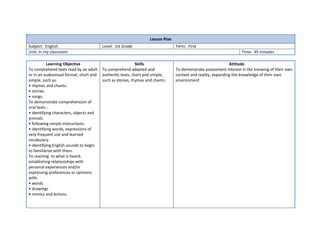
1st Grade English Lesson on Colors & Comprehension
- 1. Lesson Plan Subject: English Unit: In my classroom Level: 1st Grade Learning Objective To comprehend texts read by an adult or in an audiovisual format, short and simple, such as: • rhymes and chants. • stories. • songs. To demonstrate comprehension of oral texts : • identifying characters, objects and animals. • following simple instructions. • identifying words, expressions of very frequent use and learned vocabulary. • identifying English sounds to begin to familiarize with them. To reacting to what is heard, establishing relationships with personal experiences and/or expressing preferences or opinions with: • words • drawings • mimics and actions. Skills To comprehend adapted and authentic texts, short and simple, such as stories, rhymes and chants. Term: First Time: 45 minutes Attitude To demonstrate assessment interest in the knowing of their own context and reality, expanding the knowledge of their own environment.
- 2. Previous knowledge - Colors Content - Colors - Questions - Numbers 1-10 Activities Students listen carefully to a story that the teacher reads out loud or projects. To comprehend it, students look at the images that the teacher shows while reading. The teacher asks some questions and comments about the story, such as I like this story; The monkey looks happy; Who is he? Specific activities Students identify the colors related with the story that they have heard and complete a worksheet. Sequence Introduction 1. Students name the colors of showed images. 2. Students choose their favorite color. Core 1. Students heard the story “Kites”. 2. Students answer worksheet according to the narration. Closure 1. Students draw and color their favorite part of the story. 2. Students share their drawings with their rest of the class. Learning Resources - - Images of colors. Digital book “Kites”. https://voicethread.com/s hare/5181244/ Computer. Internet connection. Projector. Worksheet. Crayons. Assessment Criteria Students listen carefully to stories very brief and simple, read it out loud. Students identify colors. Students answer question ask by the teacher (like: What’s this? How many…? Is it…?) with help. Students draw images related with heard stories or articles.
